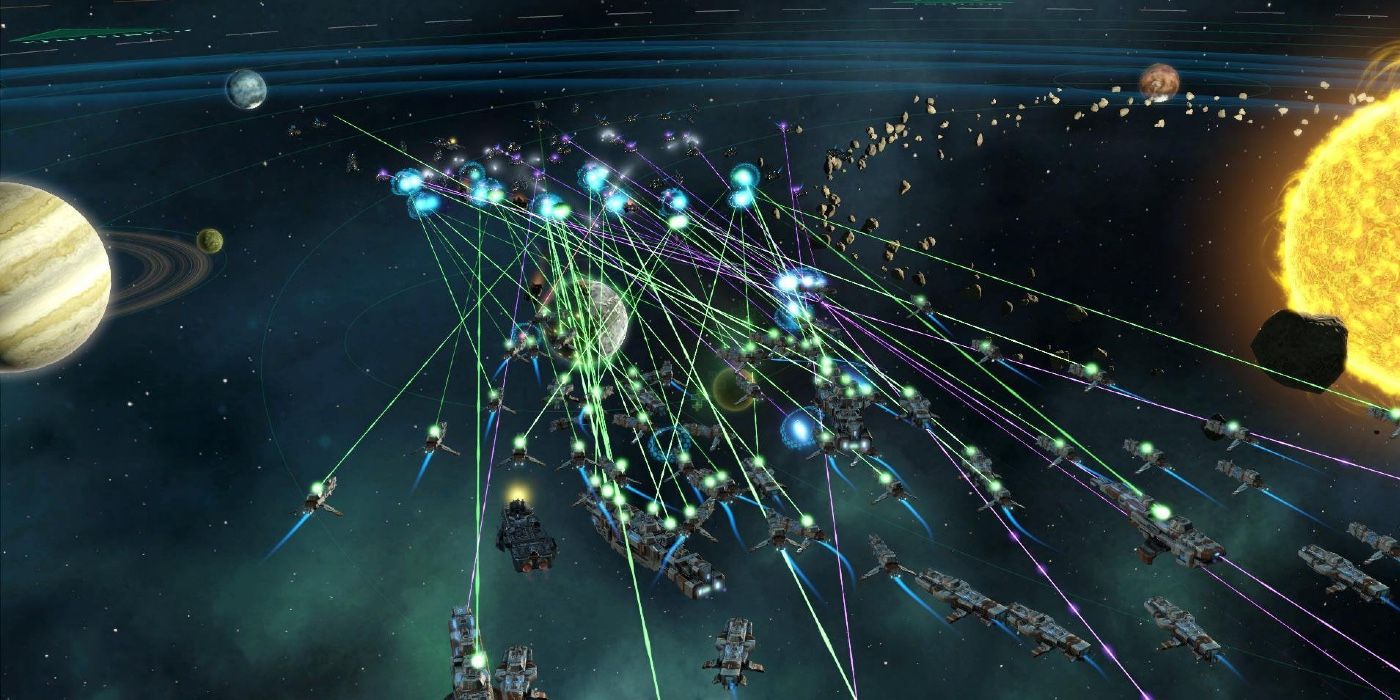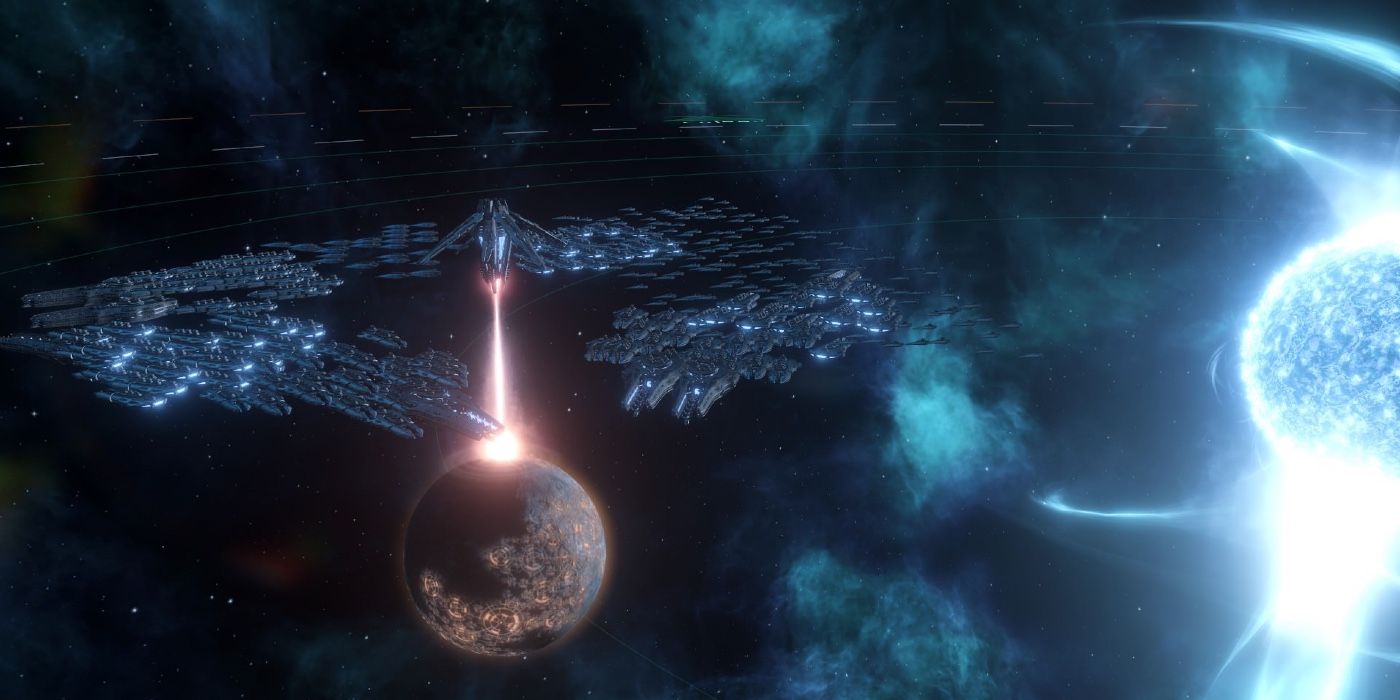
War is almost inevitable in Stellaris. However you’ve found yourself in a war, your Empire's ultimate goal is not only to survive but also to thrive in the galaxy. For an Empire to start a war, it needs a Casus Belli – a reason to declare war. Each Casus Belli grants access to a different type of Wargoal. Once war has been declared, the defending Empire has one in-game year to choose its Wargoals. These Wargoals can affect how likely it is for an opposing side to surrender to your terms or at least agree to a truce.
Combat in Stellaris takes place in real-time, and though the player can direct a fleet toward or away from enemies, there’s no control over them once they’ve engaged an enemy. When fighting a battle against any enemies, if you click on the battle, a menu will provide you a real-time report of how the battle is going. As the battle progresses, the report sub-screen shows breakdowns of the effectiveness of the weapons systems in use and how much damage the shields, armor and hulls have taken. Analyzing this data helps determine whether your ship's current designs are effective against your opponent. Your early engagements can be an effective way of determining your enemy’s strengths for you to counter and their weaknesses so you can exploit them.

All ships of a fleet in combat have the opportunity to trigger an emergency retreat in the middle of a battle. This is a sudden escape using each ship's equipped FTL engine, whether it is a Hyperdrive or Jump Drive, that allows the fleet to escape destruction. The order is given by pressing the Retreat button in the combat sub-screen, and the retreat can be triggered even from deep within the system. While on Evasive stance, a fleet will automatically retreat once the option is available. AI fleets in neutral or hostile territory will always retreat if half of the fleet is destroyed.
Each fleet is shown on the screen with a strength number, representing the power of this fleet as measured by its ships' combined offensive strength. An Admiral can command fleets you recruit, providing extra strength to their forces, especially with a useful trait. Having a sizable Naval Capacity means you’ll be able to build large numbers of warships, and having a large Fleet Capacity determines how many ships you can include in each fleet.

What kinds of ships you decide to build can also be a huge determinant in battle. For example, Corvettes and Destroyers are small and not much of a threat individually, but hundreds of them can overwhelm the enemy through sheer numbers. If you value quality over quantity, Cruisers, Battleships and Titans can take and dish out a lot of punishment on the enemy but take significant time and resources to complete. An ideal fleet should have large numbers of Corvettes to rush the enemy and get in close, while Battleships and Titans provide covering fire from afar.
If your fleet has earned a hard-won victory but suffered damage as a result, it's best to return to your nearest shipyard to make repairs. Otherwise, a newly arriving fleet could easily destroy yours. A helpful workaround is to research and equip your fleets with Regenerative Hull Tissue technology, which will gradually repair your hull and armor.
In the Edicts UI tab, several Strategic Resource Edicts can offer your ships a useful edge in combat, such as Exotic Gases for Shield Boost, which can increase the Shield Strength of all your ships by 25%. All of these Edicts require that you have a stockpile of various Strategic Resources and will only last for roughly 10 years but can give your fleets a little extra power. There's also the Policies UI tab, depending on what war you find yourself in. When you’ve completed the Supremacy Tradition tree, you’ll unlock the War Doctrine policy, which determines the overall strategic military doctrine your fleets will follow. These options include Defense in Depth, Hit and Run, Rapid Deployment and No Retreat.

If your Empire’s fleets aren’t as large or as powerful as a rival’s, increasing your starbase defenses can give you a home-front advantage. Starbases with defensive modules, buildings and defense platforms can be difficult to defeat, especially when they’re supported by a fleet in the system. Where they’re placed can also be an effective way of slowing, surprising or even stopping an enemy. Certain systems can negatively affect ships, such as Pulsars disabling all shields, Black holes making it harder for ships to disengage or retreat or Neutron Stars slowing sublight speeds by 50%. If a star system exists within a Nebula Cloud, all sensor coverage from outside is blocked, meaning that an empire can't see what is within and beyond a nebula's hyperlanes without a ship or station present.
While space combat is central in Stellaris, ground warfare is important in a different way. To capture enemy planets, armies will be needed, along with the preparation and battlefield awareness to use them properly. However, planets can only be invaded once the system's starbase has been captured or destroyed. Certain buildings automatically recruit defense armies, but assault armies need to be manually recruited and transferred to transport ships. Keep in mind that these transports have no way of defending themselves, and if an enemy fleet comes across them, they could all be destroyed. It's best to have them escorted by a proper fleet and only enter a hostile system once the way is clear.

Once a transport fleet is ordered to land on the planet, a planetary invasion will begin. Ground combat takes place between the planet owner's defense armies and the invader's assault armies. The number of armies that can be engaged in combat on either side is five plus one-fifth of the planet's size. Armies not engaged in combat will be placed a row behind the fighting armies and replace any killed army. An attacker can always attempt to retreat, but there’s a chance that each retreating army is destroyed while attempting to return to space. If a planet is too well defended to invade, a fleet can be ordered to enter the planet's orbit and conduct an orbital bombardment to soften the target. The fleet size determines the effectiveness of bombardment.
Over time, both you and the opposing side will get more and more tired of war. War Exhaustion measures the total exhaustion and attrition of all Empires on one side or the other from 0% to 100%. Exhaustion is naturally accumulated over time and referred to as attrition, but can also be increased from suffering losses and defeats in war. This includes defeats in space and land battles, territory and planets being occupied, and the outright destruction of entire worlds.
0 Comments